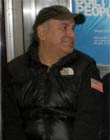|
|
 
|
|
Author
|
Topic: Kill Bill Vol. 2
|
|
|
|
|
|
|
|
|
John Pytlak
Film God

Posts: 9987
From: Rochester, NY 14650-1922
Registered: Jan 2000
|
 posted 04-01-2004 10:01 AM
posted 04-01-2004 10:01 AM





quote:
Does this mean it was shot in Super35?
The "Super Panavision 35 3-Perf" Camera aperture is 0.980 x 0.546 inches. The area "extracted" for 2.39:1 35mm "scope" release would usually be 0.945 x 0.394 inches:
http://www.cameraguild.com/magazine/stoo1003.htm
quote:
Tarantino always visualized Kill Bill as a widescreen (2.4:1 aspect ratio) movie. Richardson prefers shooting in anamorphic format, because of the degradation of image quality inherent to the optical extraction required by the Super 35 format.
“Casino was the only film I’ve shot in Super 35 format,” he says, “and I was terribly disappointed with the release print quality. It was devastating to me. Quentin had a similar experience with Reservoir Dogs. Films stocks and lenses have improved, but there is still a chasm (separating the Super 35 and anamorphic formats).”
The problem was that Tarantino had written specific “zoom” lens shots into the script. Richardson felt that the anamorphic zoom lenses available from Panavision didn’t provide a fast enough T-stop to properly execute those shots. That drove the decision to use a digital intermediate process. That approach enabled Richardson to shoot with spherical lenses in Super 35 format and “squeeze” the images into a 2.4:1 aspect ratio during digital mastering. Basically, the edited cut of the negative is scanned and converted to digital files. The images are timed for shot-to-shot and scene-to-scene continuity in a digital suite, and then recorded out to an intermediate film used as a master for release printing. It’s a familiar tactic for Richardson, who has shot many commercials that have been converted to digital format and manipulated in telecine suites. However, this is his first experience with a “film-out” from a digital intermediate.
He suggested shooting Kill Bill in three-perforation 35mm format. That trimmed film and lab costs by 25 percent. Richardson explains that essentially covered costs for the digital intermediate process. There is no downside, since the digital files can be recorded out to a four-perf 35mm color intermediate film with no loss of picture quality.
Front-end processing and release printing were slated for Technicolor Labs, in Los Angeles. Tarantino agreed with Richardson’s suggestion about creating and timing a digital file at Technique, the lab’s subsidiary in the Los Angeles area.
| IP: Logged
|
|
|
|
|
|
|
|
|
|
|
|
|
|
All times are Central (GMT -6:00)
|
|
Powered by Infopop Corporation
UBB.classicTM
6.3.1.2
The Film-Tech Forums are designed for various members related to the cinema industry to express their opinions, viewpoints and testimonials on various products, services and events based upon speculation, personal knowledge and factual information through use, therefore all views represented here allow no liability upon the publishers of this web site and the owners of said views assume no liability for any ill will resulting from these postings. The posts made here are for educational as well as entertainment purposes and as such anyone viewing this portion of the website must accept these views as statements of the author of that opinion
and agrees to release the authors from any and all liability.
|

 Home
Home
 Products
Products
 Store
Store
 Forum
Forum
 Warehouse
Warehouse
 Contact Us
Contact Us




 Printer-friendly view of this topic
Printer-friendly view of this topic







![[puke]](graemlins/puke.gif)







